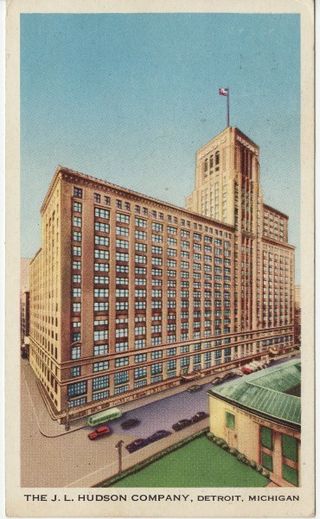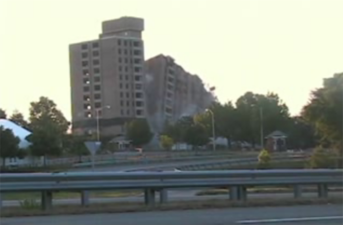
Implosion is a process in which objects are destroyed by collapsing on themselves. The opposite of explosion, implosion reduces the volume occupied and concentrates matter and energy. True implosion usually involves a difference between internal (lower) and external (higher) pressure, or inward and outward forces, that is so large that the structure collapses inward into itself, or into the space it occupied if it is not a completely solid object. Examples of implosion include a submarine being crushed from the outside by the hydrostatic pressure of the surrounding water and the collapse of a massive star under its own gravitational pressure.
A controlled explosion is the deliberate detonation of an explosive, generally as a means of demolishing a building or destroying a second improvised or manufactured explosive device.

The Genesee Towers was the tallest building in Flint, Michigan, United States. It was demolished on December 22, 2013 after a period of inactivity and loss of occupancy.

Inverkip power station was an oil-fired power station in Inverclyde, on the west coast of Scotland. It was closer to Wemyss Bay than Inverkip, and dominated the local area with its 236 m (774 ft) chimney, the third tallest chimney in the UK and Scotland's tallest free-standing structure. In common with other power stations in Scotland it lacked cooling towers; instead, sea water was used as a coolant. The station consisted of three generating units with a combined total rating of 2028 megawatts (MW).

Didcot power station is an active natural gas power plant that supplies the National Grid. A combined coal and oil power plant, Didcot A, was the first station on the site, which opened in 1970 and was demolished between 2014 and 2020. The power station is situated in Sutton Courtenay, near Didcot in Oxfordshire, England. Didcot OCGT is a gas-oil power plant, originally part of Didcot A and now independent. It continues to provide emergency backup power for the National Grid.

The J. L. Hudson Building ("Hudson's") was a department store located at 1206 Woodward Avenue in downtown Detroit, Michigan. It was constructed beginning in 1911, with additions throughout the years, before being "completed" in 1946, and named after the company's founder, Joseph Lowthian Hudson. Hudson's first building on the site opened in 1891 but was demolished in 1923 for a new structure. It was the flagship store for the Hudson's chain. The building was demolished in a controlled demolition on October 24, 1998, and at the time it was the tallest building ever imploded.

Some conspiracy theories contend that the collapse of the World Trade Center was not solely caused by the airliner crash damage that occurred as part of the September 11 attacks, and the resulting fire damage, but by explosives installed in the buildings in advance. Controlled demolition theories make up a major component of 9/11 conspiracy theories.

DocuSign Tower, previously the Wells Fargo Center, is a skyscraper in Seattle, in the U.S. state of Washington. Originally named First Interstate Center when completed in 1983, the 47-story, 574-foot (175 m) tower is now the ninth-tallest building in the city, and has 24 elevators and 941,000 square feet (87,400 m2) of rentable space. The design work was done by The McKinley Architects, and it was owned by Chicago-based EQ Office.
Controlled Demolition, Inc. (CDI) is a controlled demolition firm headquartered in Phoenix, Maryland. The firm was founded by Jack Loizeaux who used dynamite to remove tree stumps in the Baltimore, Maryland area, and moved on to using explosives to take down chimneys, overpasses and small buildings in the 1940s. The company has demolished several notable buildings by implosion, including the Gettysburg National Tower, the Seattle Kingdome, and the uncollapsed portion of the Champlain Towers South condominium.
Matla Power Station in Mpumalanga, South Africa, is a coal-fired power plant operated by Eskom and consuming the output from the Matla coal mine.
1515 Tower was a former residential high-rise in West Palm Beach, Florida. Completed in 1974, it was the second tallest building in West Palm Beach with 30 stories and rising 98 metres (322 ft). 1515 Tower was heavily damaged during Hurricane Frances and Hurricane Jeanne in 2004 and was subsequently vacated. The facade was heavily damaged as a result of the storms, and on August 1, 2006, the city issued a demolition order. The building was demolished by use of explosives, colloquially called implosion, on Sunday, February 14, 2010. 1515 Tower was the third tallest building in the United States to be imploded. There have been several proposals for a new building at the site at 1515 South Flagler Drive.

The implosion of Radio Network House in 2012 was the first implosion used in New Zealand to demolish a building, and was a "test case" for the potential to use such a demolition method on similar buildings in Christchurch Central City that had been damaged in the 2011 earthquake. Like most other large buildings in central Christchurch, Radio Network House was damaged beyond repair in the 2011 earthquake, and the Canterbury Earthquake Recovery Authority (CERA) added it to the demolition list in August 2011. In July 2012, it was announced that the building was going to be imploded, involving a specialist company from the United States with considerable experience in this type of work.
Ocean Tower SPI was an unfinished, 31-story condominium in South Padre Island, Cameron County, Texas, United States, that was imploded when it was deemed unsafe to remain standing. Construction was halted in May 2008 when cracks formed in the building's supporting columns, and investigations revealed that the core of the skyscraper had sunk by more than 14 inches (360 mm). Though the developers initially vowed to fix the problem, studies discovered that repairs would have been too expensive, and plans for its demolition were announced in September 2009. At the time of its controlled implosion in December 2009 the building weighed 55,000 short tons (50,000 t), and it was the tallest reinforced concrete structure to be demolished in that way. It was nicknamed "Faulty Towers" and "The Leaning Tower of South Padre Island".

Demolition is the science and engineering in safely and efficiently tearing down of buildings and other artificial structures. Demolition contrasts with deconstruction, which involves taking a building apart while carefully preserving valuable elements for reuse purposes.

The Landmark Tower was a 30-story skyscraper located at 200 West 7th Street in Downtown Fort Worth, Texas. Designed by Fort Worth architecture firm Preston M. Geren & Associates, Landmark Tower was the tallest building in the city from its opening in 1957 until the completion of the Fort Worth National Bank Tower in 1974. After being abandoned in 1990, the tower stood vacant for more than 15 years until it was demolished in 2006. It is one of the tallest buildings ever to be demolished.

The Christchurch Central Police Station was the former headquarters of the Canterbury Police District. Once the tallest building in Christchurch, New Zealand, it was damaged in the 2011 Christchurch earthquake and demolished by implosion on 31 May 2015.

The McGuire Apartments was a 25-story apartment building in the Belltown neighborhood of Seattle, Washington. The $32 million, 272-unit building opened in 2001, but was closed in 2010 after the discovery of major structural flaws and corrosion that forced evacuation and demolition. The building was demolished in 2011 using heavy machinery and filled with dirt. The site was re-excavated in 2017 for a new residential building that opened in 2019.

The Capital Plaza Office Tower was a 338-foot tall, 28-story office skyscraper located at 500 Mero Street in Frankfort, Kentucky. It was the tallest building in Frankfort and the 11th tallest building in the state of Kentucky.
The Apex Tower and Ceyane Tower, colloquially referred to as the Noida Supertech Twin Towers, were incomplete residential buildings in Sector-93A, Noida, Uttar Pradesh, India. The towers were part of real estate company Supertech Limited's Emerald Court residential complex. The Supreme Court of India upheld the original decision by the Allahabad High Court and ordered the buildings' demolition on 31 August 2021. They are the tallest structures in India to be voluntarily demolished.

















